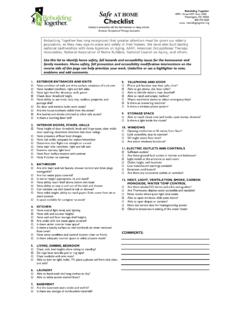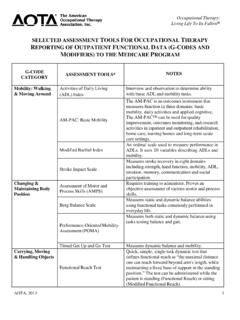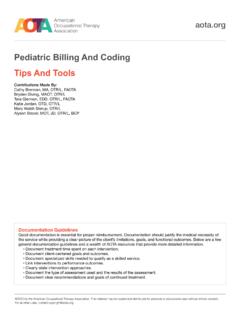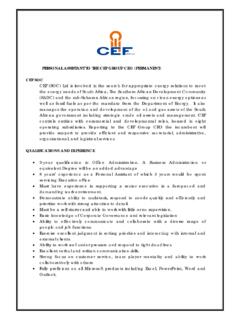Transcription of Model State Regulation for Supervision, Roles, and ...
1 Model State Regulation for Supervision, Roles, and Responsibilities During the Delivery of Occupational Therapy Services 1. Purpose The purpose of this Model State Regulation for Supervision, Roles, and Responsibilities During the Delivery of Occupational Therapy Services is to provide a template for use by State agencies and occupational therapy regulatory boards when drafting or revising regulations to govern the clinical supervision of occupational therapy assistants, limited permit holders, and aides. The Model is intended to help safeguard the public health, safety and welfare by establishing guidelines that are consistent with professional standards and accepted practice in the profession. 2. Definitions A. In this section, the following terms have the meanings indicated.
2 (1) "Aide" means a person who is not licensed by the Board and who provides supportive services to occupational therapists and occupational therapy assistants. An aide shall function under the guidance and responsibility of the occupational therapist and may be supervised by the occupational therapist or an occupational therapy assistant for specifically selected routine tasks for which the aide has been trained and has demonstrated competency. (2) Board means the _____ State Board of Occupational Therapy Practice. (3) Competence refers to an individual's capacity to perform job responsibilities. (4) Competency refers to an individual's actual performance in a specific situation. (5) Limited permit holder means an individual who has completed the academic and fieldwork requirements of this Act for occupational therapists or occupational therapy assistants, has not yet taken or received the results of the entry level certification examination, and has applied for and been granted limited permit status.
3 (6) "Occupational therapist" means an occupational therapist who is licensed by the Board. (7) "Occupational therapy assistant " means an occupational therapy assistant who is licensed by the Board to provide occupational therapy services under the supervision of and in partnership with a licensed occupational therapist. (8) "Supervision means a cooperative process in which two or more people participate in a joint effort to establish, maintain, and/or elevate a level of competence and performance. Within the scope of occupational therapy practice, supervision is aimed at ensuring the safe and effective delivery of occupational therapy services and fostering professional competence and development. 3. Scope of Occupational Therapy assistant 's License A. In general - An occupational therapy assistant 's license authorizes the licensee to provide occupational therapy services under the supervision of and in partnership with a licensed occupational therapist.
4 B. Supervision required - A licensed occupational therapy assistant may practice only under the supervision of an occupational therapist who is authorized to practice occupational therapy in this State . The American Occupational Therapy Association, 4720 Montgomery Lane, Bethesda, MD 20814 1. 4. Supervision of Occupational Therapy Assistants A. Supervision involves guidance and oversight related to the delivery of occupational therapy services and the facilitation of professional growth and competence. It is the responsibility of the occupational therapist and the occupational therapy assistant to seek the appropriate quality and frequency of supervision to ensure safe and effective occupational therapy service delivery. B. The specific frequency, methods, and content of supervision may vary by practice setting and are dependent upon the (1) complexity of client needs, (2) number and diversity of clients, (3) skills of the occupational therapist and the occupational therapy assistant , (4) type of practice setting, (5) requirements of the practice setting, and (6) other regulatory requirements.
5 C. More frequent supervision may be necessary when (1) the needs of the client and the occupational therapy process are complex and changing, (2) the practice setting provides occupational therapy services to a large number of clients with diverse needs, or (3) the occupational therapist and occupational therapy assistant determine that additional supervision is necessary to ensure safe and effective delivery of occupational therapy services. D. A variety of types and methods of supervision may be used. Methods may include direct face-to-face contact and indirect contact. Examples of methods or types of supervision that involve direct face-to-face contact include but are not limited to observation, modeling, co-treatment, discussions, teaching, instruction, and video teleconferencing.
6 Examples of methods or types of supervision that involve indirect contact include but are not limited to phone conversations, written correspondence, electronic exchanges, and other methods using secure telecommunication technology. All methods should be compliant with confidentiality requirements of government agencies, facilities, employers, or other appropriate bodies. E. Occupational therapists and occupational therapy assistants must document a supervision plan and supervision contacts. Documentation should include the (1) frequency of supervisory contact, (2) method(s) or type(s) of supervision, (3) content areas addressed, (4) names and credentials of the persons participating in the supervisory process. 5. Supervision of a Limited Permit Holder A.
7 An occupational therapist limited permit holder or occupational therapy assistant limited permit holder who has not yet taken or received the results of the entry-level certification examination shall practice under the supervision of an occupational therapist. It is the responsibility of the supervising occupational therapist to provide and the limited permit holder to seek the appropriate quality and frequency of supervision to ensure safe and effective occupational therapy service delivery. The American Occupational Therapy Association, 4720 Montgomery Lane, Bethesda, MD 20814 2. 6. General Roles and Responsibilities of the Occupational Therapist and the Occupational Therapy assistant A. The occupational therapist is responsible for all aspects of occupational therapy service delivery and is accountable for the safety and effectiveness of the occupational therapy service delivery process.
8 The occupational therapy service delivery process involves evaluation, intervention planning, intervention implementation, intervention review, and outcome evaluation. B. The occupational therapist must be directly involved in the delivery of services including during the initial evaluation and regularly throughout the course of intervention and outcome evaluation. C. The occupational therapy assistant delivers occupational therapy services under the supervision of and in partnership with the occupational therapist. D. It is the responsibility of the occupational therapist to determine when to delegate responsibilities to occupational therapy assistants. It is the responsibility of the occupational therapy assistant who performs the delegated responsibilities to demonstrate competency.
9 E. The occupational therapist and the occupational therapy assistant should be able to demonstrate and document competency for clinical reasoning and judgment during the service delivery process as well as for the performance of specific techniques, assessments, and intervention methods used. F. When delegating aspects of occupational therapy services, the occupational therapist considers the following factors: (1) The complexity of the client's condition and needs (2) The knowledge, skill, and competence of the occupational therapy assistant (3) The nature and complexity of the intervention (4) The needs and requirements of the practice setting 7. Specific Roles and Responsibilities During the Delivery of Occupational Therapy Services Regardless of the setting in which occupational therapy services are delivered, the occupational therapist and the occupational therapy assistant assume the following generic responsibilities during evaluation, intervention, and outcomes evaluation.
10 A. Evaluation (1) The occupational therapist directs the evaluation process. (2) The occupational therapist is responsible for directing all aspects of the initial contact during the occupational therapy evaluation, including: a. determining the need for service, b. defining the problems within the domain of occupational therapy that need to be addressed, c. determining the client's goals and priorities, d. establishing intervention priorities, e. determining specific further assessment needs, and f. determining specific assessment tasks that can be delegated to the occupational therapy assistant . (3) The occupational therapist initiates and directs the evaluation, interprets the data, and develops the intervention plan. (4) The occupational therapy assistant contributes to the evaluation process by The American Occupational Therapy Association, 4720 Montgomery Lane, Bethesda, MD 20814 3.















